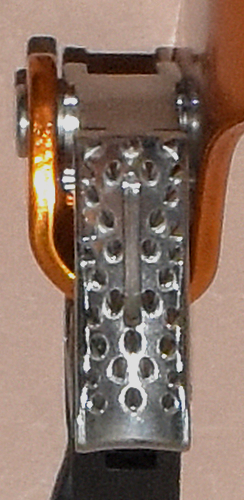Technical Details
I acquired my Wildken ascender from Amazon.com in 2021.
 The ascender is left-handed, as are most chest ascenders I have seen.
The ascender is 110 mm. tall, 71 mm. wide, 39 mm. thick, and weighs 121 g. The ascender shell is subtriangular
blue anodized shape bent from 3.3 mm. aluminum sheet. The
rope channel is formed by bending the right side of the ascender
into a U. The rope channel is 13 mm. wide. The main sling attachment point is located below the cam and behind the
rope channel. A second attachment point is located above the cam,
also behind the rope channel. The shell is bent backwards at both
points to provide clearance between the attachment slings and
the main rope. This accounts for the rather large thickness of
this ascender. The attachment points appear to be ovals distorted
by the stamping operation. The lower attachment point measures
21.9 by 19.8 mm. and the upper 24.0 by 16.4 mm. The left side
of the shell is bent on an inclined axis to form another U. A
hole drilled through both sides of the U accepts a semi-tubular rivet.
The cam and cam spring are mounted on this rivet. The pivot is centered
42 mm. from the inside of the rope channel.
The ascender is left-handed, as are most chest ascenders I have seen.
The ascender is 110 mm. tall, 71 mm. wide, 39 mm. thick, and weighs 121 g. The ascender shell is subtriangular
blue anodized shape bent from 3.3 mm. aluminum sheet. The
rope channel is formed by bending the right side of the ascender
into a U. The rope channel is 13 mm. wide. The main sling attachment point is located below the cam and behind the
rope channel. A second attachment point is located above the cam,
also behind the rope channel. The shell is bent backwards at both
points to provide clearance between the attachment slings and
the main rope. This accounts for the rather large thickness of
this ascender. The attachment points appear to be ovals distorted
by the stamping operation. The lower attachment point measures
21.9 by 19.8 mm. and the upper 24.0 by 16.4 mm. The left side
of the shell is bent on an inclined axis to form another U. A
hole drilled through both sides of the U accepts a semi-tubular rivet.
The cam and cam spring are mounted on this rivet. The pivot is centered
42 mm. from the inside of the rope channel.
The cam is a stainless steel casting. The cam radius increases from 38 to 54 mm. over an angle of 35°, giving a 31° cam angle. The cam has number of small conical teeth,
all of which have their axes approximately aligned with the cam axle. The tooth pattern is (3.2)(1S1)^3(2S2)(1S1)^3(3.4.3).
A spring-loaded plastic safety is mounted on the bottom of
the cam with a stainless steel rivet. The normal action
of the spring holds the safety against the cam. When the cam is
opened, the shell interferes with the safety bar, thus preventing
opening the cam. If the safety bar is moved away from the cam
(opposing the spring), it will clear the shell and the cam will
open. At full open the safety can be released and the spring will
hold the safety against the back of the shell. This provides a
means of locking the cam open.
The front of the rope channel is printed with a hollow up-pointing arrow with, "UP" inside and "ROPE110≤Ø≤13 mm." The rear is printed with the Wildken logo, a reading-is-dangerous icon, "ABDR," "EN12841:2006B," "CE1282 EN567," and "1Ø10-13mm - MAX 100kg."
|
 |
Warning:
The weight ("100kg") printed on the shell can easily be
less than the weight of a fully loaded caver. |
 |
|
This is another well-made ascender. All sharp edges have been
removed. The cam is very well made with sharp, well-formed teeth. The plastic safety resembles those on some of the later Petzl Crolls.
The weight rating ("100kg") printed on the rear of each ascender can easily be less than the weight of a fully loaded caver. Although I know what this means, American courts may not, so I cannot recommend this ascender for heavier cavers or for expedition caving.
The Wildken ascender is essentially identical to the Camnal Ascension.

For far more content, use a larger monitor and a full-width window.
Hundreds of cell phone users complained and asked me to for a simpler, mobile friendly site. In particular, they wanted me to limit each page to a small number of pictures and minimize my use of text. This new site provides what they asked for.

